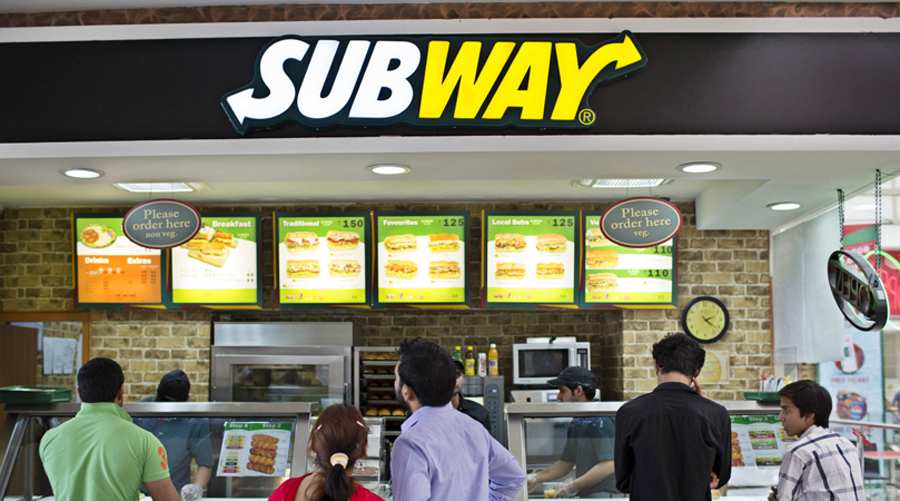If you’re looking for a powerhouse franchise, an established force that has a vast, international reach, you can’t do much better than Subway:
If you’re looking for a powerhouse franchise, an established force that has a vast, international reach, you can’t do much better than Subway. With 35,954 locations in 98 countries, the company, based in Milford, Conn., is one of the largest franchisors in the world. That’s a far cry from its humble beginnings in 1965, when a teenager by the name of Fred DeLuca and a family friend opened a submarine sandwich shop in Bridgeport, Conn. They eventually changed the name to Subway and started franchising in 1974.
Now the company is a major player in the $200 billion quick-service restaurant industry, which is expected to grow 3% a year for the next five years, according to Don Fertman, Subway’s chief development officer, who has been with the company for 30 years. Subway, with revenues of about $17 billion, should grow at a slightly higher rate, according to Fertman. “Quick-service restaurants do pretty well in a down economy,” says Fertman. “People start switching from more upscale places, and that means more opportunity for our segment.”
The Company
The Service
Subway differentiates itself by using fresh ingredients and selling healthy food. It also lets customers choose how they want their sandwiches to be made, from the type of bread to the specific veggies.
Subway has a financing program aimed at minorities that many immigrants can benefit from.
Training
The first step is an online course that all new franchisees have to take. Then there’s a two-week training class held at headquarters, as well as regional and country offices, offered in a number of languages. Courses are part-classroom learning, part in-store training. After that, franchisees have access to ongoing training through online courses. Plus, throughout the year, Subway holds training seminars and roundtables at a variety of conferences.
Immigrant-friendly Policies
While he can’t provide numbers, a “substantial percentage” of franchisees are immigrants, according to Fertman. There are no specific immigrant-friendly policies, but Subway has a financing program aimed at minorities that many immigrants can benefit from.
Funding
In addition to the minority-funding program, Subway can refer franchisees to preferred lenders, who generally provide financing at a competitive rate. Plus, another group of lenders works with an independent purchasing co-op run by franchisees. Subway also runs an equipment-leasing program, which is of particular importance, since equipment represents a significant part of the franchisee’s total investment.
“We’re looking for people who are entrepreneurs, but who are also willing to follow directions.”
What you’ll need
First of all, there’s the matter of a site. The size of your location can range widely, from 300 square feet to 2,000 square feet or more. Generally, Subway franchisees lease their space, although in some cases they buy the building, according to Fertman. A good resource is your local Subway developer, who can help you determine the criteria for a good location. Because a developer is in constant touch with major landlords in the area, he can often know about potential spaces. What’s more, once you’ve pinpointed a potential location, a developer can evaluate whether or not the site has the potential to be profitable.
Then there’s the necessary equipment, including refrigerators, ovens, vegetable slicers and the like, as well as counters and a point-of-sale system. Perhaps 40% of most stores’ business comes from sit-down customers, according to Fertman, so you’ll also probably need seating.
Startup costs
They range from $84,000 to $250,000 or more, depending on location, size of equipment, and extent of renovations required.
Return on Investment
While Fertman can’t reveal financial specifics, he suggests you talk to existing franchisees to get information about potential return. “Profitability varies from store to store,” he says. “It depends on the amount of food traffic you get, the size of your lease and so many different factors.” One indication of how quickly you can turn a profit: Franchisees frequently open a second location six months after launching their first one.
What They’re Looking for in Prospective Franchisees
Franchisees are expected to be active, on-site managers. For that reason “we want people who can be hands-on operators,” says Fertman. “The folks who get behind the counter, learn the business from the inside, make the sandwiches, work with the customers are those who grow their businesses effectively. Passive investment doesn’t work.” Demonstrating an entrepreneurial bent is also important, and so is a willingness to share ideas with other franchisees. At the same time, franchisees need to be able to follow the rules. “It’s kind of a paradox,” says Fertman. “We’re looking for people who are entrepreneurs, but who are also willing to follow directions.”
Tips for the immigrant buyer
If you’re interested in Subway, you need to be persistent, according to Fertman. “With the large number of locations operating here in North America, the window of opportunity is a lot smaller than it used to be,” he says. Once you’ve filled out an application, it’s important to meet with the developer in your area to demonstrate your belief in the Subway brand, as well as your willingness to follow the system and be a hands-on owner-operator. “That will give you a much better shot at becoming a franchisee,” says Fertman.

